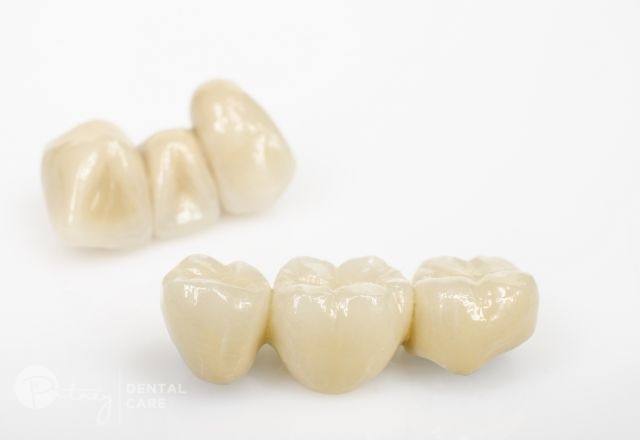What’s the Difference Between a Dental Bridge & Implant

Even with your best efforts in preventative care, there may be a time when you need one or more teeth replaced. This may be due to recent and sudden trauma, gum disease or tooth decay. Regardless of the cause, it can be disheartening to have missing teeth, which is why you may be eager to find a way to replace the empty spot in your smile.
This leaves you with an important decision to make; dental implants or a dental bridge?
Both options are capable of filling the gaps left behind by missing teeth, but it can be hard to know which option is better, let alone what the differences between the treatment options are. That is why we are looking to answer these questions and more in this article, helping you find the best option for your teeth.
What is a Dental Bridge?
A dental bridge is a dental prosthesis that works well to replace multiple missing teeth or just a single tooth. To fix the prosthesis in place, the teeth surrounding the missing tooth or teeth will serve as an anchor point for the bridge. This creates the appearance of a complete dental set as the dental bridge blends in with your natural teeth.
Pros of a Dental Bridge
There are several benefits of choosing a dental bridge as a tooth replacement option. Beyond having a natural-looking appearance, bridges also have the monetary and health benefits of:
- Likely to be covered by your health insurance
- Requiring only two appointments on average, spread across several weeks
- The surrounding teeth of the missing tooth are prevented from attempting to close the gap
- Often a lower upfront cost than dental implants
- Does not require invasive surgery or bone grafting
Cons of a Dental Bridge
Even with their several benefits, dental bridges do still come with some cons that may affect your decision to choose a tooth bridge vs implant:
- While a bridge can last more than 10 years in some cases, most need to be replaced every 5-7 years
- Requires the surrounding teeth to have their enamel filed down for successful placement, putting them at risk of further dental problems
- There is a higher chance of developing cavities or tooth decay in the surrounding teeth than with a dental implant
- Often loses its natural-looking appearance with time
- Can cause damage to the healthy teeth around the missing tooth
- While it replaces the tooth loss above the gum line, it cannot prevent bone loss beneath it
- Requires more specialised care to keep clean
What is a Dental Implant?
A dental implant differs greatly from dental bridges in many ways, least of all their installation process and functionality. Dental implants offer a procedure that secures an artificial replacement tooth to the jaw bone, rather than creating a prosthesis bridge.
The treatment process requires a metal fixture, commonly a titanium or stainless-steel screw, to be attached to the replacement tooth implant so it can be secured into the bone. Over time, the bone surrounding your dental implant will grow to secure the new tooth in place, allowing it to fuse with the gums and jaw bone alike.
Pros of a Dental Implant
When it comes to dental implants, there are several benefits to consider, including:
- Being one of dentistry’s longest-lasting missing teeth solutions, with implants lasting up to 15 years or more with proper care
- Does not damage any of the healthy adjacent teeth to the installation site
- Has the same look and feel as your natural teeth, often retaining appearance longer than dental bridges
- Decreases the chance of bone loss under the gums
Cons of a Dental Implant
- Less likely to be covered by any health insurance
- Requires a surgical or invasive procedure, including bone grafting
- The invasive procedure carries risks and may lead to complications
- Higher upfront cost than dental bridges
- The full installation process can take up to six months, often requiring temporary dental crowns between appointments
- Cannot be done for those who have gum disease or any other health conditions that affect healing
Dental Bridge vs Implant Procedure
One of the other major differences to consider between a tooth implant vs bridge is the procedure required to replace missing teeth. Both tooth replacement options can be done on one or multiple teeth if necessary, but how the artificial teeth are installed can affect one’s decision to replace lost teeth.
Dental Bridge Procedure
After an initial examination of your dental health to assess any additional signs of decay, disease or damage to structural integrity, the process of fitting your new dental bridge can begin so long as there are no issues. Any issues with your dental health must be addressed before a bridge is installed as it would trap any existing tooth damage and cause further complications.
Once you have a clean bill of health, a dentist will file down the existing teeth around the tooth replacement site and take an impression of the gap. This will create a mould that your dental bridge will be based on, which usually takes 2-4 weeks. During this waiting time, you will be fitted with a temporary bridge to keep the site clean and healthy until your dentist instals your permanent bridge.
Dental Implant Procedure
Dental implants often require several appointments to be finalised due to necessary healing breaks to see if your body accepts the new implants. However, the overall process is simpler than expected, just lengthened by healing time in between steps:
- Initial consultation: Your dentist will determine whether you are suitable for a dental implant before making an examination, photograph and dental cast of your teeth. They may also make a 3-D scan of your jaw.
- Extraction and grafting: If you still have damaged or decayed teeth in place, an extraction may be necessary. For those whose jaw bone is too weak or damaged for dental implants, you may require bone grafting or a sinus lift to make the treatment feasible. Both procedures require 3-12 months of healing before implant dentistry can continue.
- Implant insertion: Your dentist will create an insertion site in your gum line and bone using local anaesthesia. Then they will drill a hole for a metal post to be screwed into place, after which the gum tissue is sutured over the implant to prevent debris from entering the healing site. Stitches are removed after 2 weeks.
- Insertion of the abutment: The support post and connecting piece between the dental implant and fake tooth, otherwise known as the abutment, is fitted. Your implant can rarely be inserted during the same appointment, so a temporary crown is usually placed.
- Crown attachment: After the swelling has gone down and the abutment has been accepted, your dentist can insert your permanent crown made out of your material of choice
After your dental implant surgery has been finalised it is important to keep the site clean as it heals. Always book a check-up at your local dental clinic if you notice any additional symptoms or pain.
How to Choose Between a Dental Bridge and Dental Implant
The choice between dental implants or dental bridges for your tooth replacement may be determined solely by your dentist. There may be a particular treatment method they believe will not work for you due to health conditions or other restrictions, meaning that your only choice is the one that works for you.
Overall, however, the best option for you and your teeth is the one that works best with your natural teeth and the number of missing teeth you have, is within your budget, and is within your desired time limit.
Regardless of your choice, Putney Dental Care offers expert treatment for dental implants and dental bridges alike in Sydney. If you want to replace missing teeth and recreate your natural smile, our experienced dentists are here for you. Contact us over the phone at (02) 9808 2588 or online for a consultation on missing teeth replacement.
FAQs
What is the Difference Between a Dental Crown and a Bridge?
A dental crown, otherwise known as a ‘cap’, differs from a dental bridge as it is a restoration material that is placed over damaged or weak teeth, rather than a prosthesis for replacing missing ones.
Do Bridges Last Longer than Implants?
Dental bridges may last up to 10 years or so with proper care, but they usually need replacement sooner than dental implants. Implants can last up to 15 years if maintained properly, only requiring repair if significant damage to the tooth implants has occurred.
When Should You Not Get Dental Implants?
You should not get dental implants if you are dealing with certain medical conditions that may affect your health during the process. These conditions include: gum disease, weak or growing jaw bone, those that affect healing or bone grafting, as well as systemic diseases like diabetes or Parkinson’s.
Why Do You Have a Hole in Your Gums? How to Stop Wisdom Teeth PainLatest from the Dental Blog
 17 Oct 2018
17 Oct 2018
7 Ways to Whiten Your Teeth
A smile is one of the most attractive accessories anyone can wear. However, people are often self-conscious to show-off this…
 05 Apr 2017
05 Apr 2017
Protect your teeth against cavities this Easter holiday
When was the last time you really brushed your teeth? Do you have a diet high in sugar and starches?…
 05 Jun 2023
05 Jun 2023
How to Stop Wisdom Teeth Pain
The sensation of our last teeth breaking through the gums can be a surprise to many as not everyone has…
